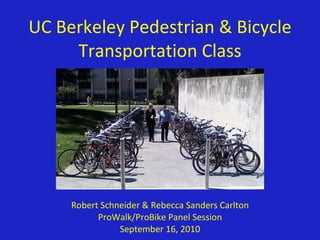Session #71 - UC Berkeley Ped & Bike Class - Schneider & Carlton
- 1. UC Berkeley Pedestrian & Bicycle Transportation Class Robert Schneider & Rebecca Sanders Carlton ProWalk/ProBike Panel Session September 16, 2010
- 2. How did the course get started? Pedestrian & bicycle course offered by DCRP faculty every 2-3 years in the 1990s Course not taught for at least 5 years Prior assumption of department: Not enough interest from students ~15 masters students organized in Fall 2007 to push for course No dept. faculty available to teach course
- 3. How did the course get started? Student-taught course in City Planning Department Department concerns: Will course meet university standards? Student leader must have faculty sponsor Course should not burden the faculty sponsor Faculty should be invited to speak/monitor course No $$$, but credits for student leader Does student leader have enough expertise & time?
- 4. Course Purpose Educate current/future professionals Learn about the state of the practice Think critically about current methods & research needs Improve the credibility of the pedestrian & bicycle field Not an ŌĆ£advocacyŌĆØ course
- 5. Course Structure 2- or 3-hour class, once per week Readings that should be on the shelf of a ped/bike professional Course wiki space http://cp298pedbiketranspo.wikispaces.com/ Class project & assignments
- 6. ╠²
- 7. Typical Class Structure Presentation on weekly topic Discussion of readings & issues Guest lecturer/discussant Government agencies Consultants Researchers Advocacy organizations
- 8. Student interests (2008-2010) Cultural change needed to get more people bicycling (and walking); public health connection Innovative pedestrian & bicycle facility designs Numbers to show benefits of ped/bike transpo. Pedestrian, bicycle, driver behaviors Perceptions of safety and risk, ŌĆ£Safety in numbersŌĆØ
- 9. Example student projects Safety evaluation of Masonic Ave. (SF) Safety of I-880 interchange crossings (Fremont, CA) Hudson River Greenway & 9 th Avenue Cycle Track (NYC) Efforts to increase walking & bicycling (NYC) Bus stop area bicycle lane design How-To Guide to Bicycle Parking Complete streets & physical activity Idaho ŌĆ£Stop as YieldŌĆØ Law Bicycle Sharing Programs SRTS Local School Project Taylor Reiss, 2010 Alia Anderson, 2008
- 10. Intersection Redesign Final assignment Field experience Work in groups Professional-style presentation Meredith Glaser, Troy Reinhalter, & Nicole Schneider, 2010
- 11. Monica Altmaier, Andy Kosinski, & Taylor Reiss, 2010
- 12. Meredith Glaser, Troy Reinhalter, & Nicole Schneider, 2010
- 13. Monica Altmaier, Andy Kosinski, & Taylor Reiss, 2010
- 14. Course Changes (2008-2010) 2 credits to 3 credits Fewer required readings More detailed assignment instructions Evening to mid-day, back to evening Panels of professionals More legal background & behavioral issues More international examples Paid student instructors
- 15. What the Students SayŌĆ” ŌĆ£ Class was a lot of work for a Pass/Fail course.ŌĆØ ŌĆ£ Wish this had been required for transportation concentration. I ended up dropping it and just sitting in.ŌĆØ ŌĆ£ The 3-hour course from 5-8 p.m. was a bit tough.ŌĆØ ŌĆ£ At timesŌĆ”the course moved too slowly.ŌĆØ Have ŌĆ£less reliance on guest speakers.ŌĆØ ŌĆ£ Would like more time for discussion.ŌĆØ ŌĆ£ In-class time to work on intersection redesign.ŌĆØ
- 16. What the Students SayŌĆ” Having lecture and guest speaker every week ŌĆ£mixes it up nicely & offers a variety of perspectives.ŌĆØ Liked ŌĆ£the real world focused projects and the walking tour.ŌĆØ Liked ŌĆ£that we are learning cutting-edge stuff.ŌĆØ ŌĆ£ It covered a topic that the department desperately needed.ŌĆØ Liked ŌĆ£the discussions where we actually disagreed.ŌĆØ ŌĆ£ One of the best classes IŌĆÖve taken here. And, it got me a job.ŌĆØ
- 17. Course Challenges Balancing core competencies and instructor strengths Scheduling guest lecturers Balancing lecture, discussion, and assignment time Encouraging students to prioritize the class Long-term vision for course Taught by full-time professor Instituted into planning & engineering curriculum
- 18. Thanks!

















